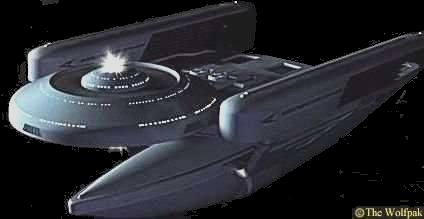
OBERTH CLASS

|
Type: |
Science vessel. Some units have been refitted as technology test beds. |
|
Commissioned: |
2269 - 2308 |
|
Dimensions: |
|
|
Length: |
123 m |
|
Beam: |
87 m |
|
Height: |
41 m |
|
Decks: |
12 including engineering, 5 habitable |
|
Mass: |
25,000 tons |
|
Crew: |
Typically 20 - 60 |
|
Armament: |
2 x Type IV Phaser banks, total output 3,500 TeraWatts |
|
Probe magazine can hold up to 25 photon torpedoes but these are rarely carried |
|
|
Defense Systems: |
Shield system, total capacity 243,000 TeraJoules |
|
Standard Duranium single hull |
|
|
Standard level Structural Integrity Field |
|
|
Warp Speeds: |
Normal Cruise: Warp 4 |
|
(TNG Scale) |
Maximum Cruise: Warp 5 |
|
Maximum Rated: Warp 5.8 for twelve hours |
|
|
Strength Indices: |
Beam Firepower: 70 |
|
(Galaxy Class = 1000) |
Torpedo Firepower: 60 |
|
Weapon Range & Accuracy: 85 |
|
|
Shield Strength: 90 |
|
|
Hull Armor: 10 |
|
|
Speed: 350 |
|
|
Combat Maneuverability: 12000 |
|
|
Overall Strength Index: 110 |
|
|
Diplomatic Capability: |
Grade 1 |
|
Expected Hull Life: |
100 years |
|
Refit Cycle: |
Minor: 1 year |
|
Standard: 4 years |
|
|
Major: 20 years |
|
|
Added Features: |
The Oberth class has a distinguished Starfleet career dating back for over a century. They are no record breakers - even when the first ship was commissioned in 2269 there were far more capable platforms from which to conduct scientific research and exploration. But the Oberth's had some crucial advantages - they were easy to build and easy to run. The design was highly modular - the whole vessel was made up of sections of 50, 150, or 300 tons which were simply bolted together and sealed. This allowed construction to take place in the smallest of facilities, even those intended to handle craft such as shuttles and small transports. The warp drive system, one of the most difficult parts of any Starship to fabricate, sacrificed a large degree of speed and acceleration in return for simplicity and reliability. These factors enabled no less than eight Oberth class vessels to be built for the same resources as a single Constitution class Starship. In service the Oberth's were just as easy to run as they were to build; the engineering plant was almost wholly automated, with the engineering hull unmanned in normal operation; the entire engineering crew consisted of one officer and four enlisted personnel, less than a tenth of the number normal for a vessel of this size |
|
The exploratory nature of the Oberth class mission meant that they would frequently discover new alien species, but their small size and limited crew numbers meant that they had a very limited diplomatic capability. Although they did occasionally engage in first contact procedures, it was more usual that an Oberth would make an initial assessment without revealing itself before reporting back to Starfleet and allowing larger vessels to make the actual contact |
|
|
Over the decades of their service the Oberth's have been produced in and upgraded to over twenty different variations. Early changes are limited to the sensor and laboratory resources, but the later models introduced improved crew facilities such as larger quarters and replicator systems, made possible by reduced crew numbers due to further automation. In the 2340's all units received new phaser banks - although the peaceful nature of the Oberth class is emphasized by the irony that this change was necessitated by new safety standards introduced for phaser equipment, and that the resultant changes actually lowered the ships phaser power by nearly 10% |
Home
Crew Intel Office Aliens Ships Technology Protocols General Orders Directives